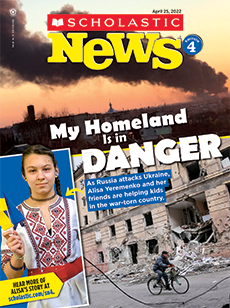Scholastic News Supports Your ELA Instruction
A Digital Resource Guide accompanies each issue of Scholastic News. It includes pre-reading activities, close-reading questions, differentiation and extension activities, content-area connections, and standards correlations. Here are some of the skills we often cover in the Digital Resource Guide:
- Citing text evidence and making inferences
- Determining main idea and identifying key details
- Summarizing
- Describing cause/effect relationships and sequencing events
- Using context clues and acquiring domain-specific vocabulary
- Using text features, such as photos and maps
- Describing connections between sentences or paragraphs
- Comparing two texts on one topic
Additionally, Scholastic News articles are instrumental for many teachers in building informational reading skills. Every issue features on-level nonfiction that gives your students ample practice reading the types of informational texts that are essential for success on tests and in higher grades.
Scholastic News Supports Your Writing Instruction
The articles in Scholastic News make excellent anchor texts to teach informational writing. You might use the articles in the following ways:
- Discuss text structure (e.g., problem/solution, cause/effect, sequence).
- Compare different ways to write introductions and conclusions.
- Highlight linking words (e.g., also, another, but).
- Analyze how authors develop topics with facts, definitions, details, and text features.
The Skill Builders also provide opportunities for students to practice their writing skills. Most require students to write responses to text-based questions. Some focus on specific editing skills, such as grammar and punctuation. Others help students plan essays or longer narrative pieces.
Scholastic News Supports Your Science and Social Studies Instruction
Many of the topics you teach in your science and social studies lessons come to life in Scholastic News. You teach students about the solar system; we give you the latest news on Mars. You discuss cultures and communities; we give you current events and maps from all over the world. With every issue, we pick news that we know will help you meet your most important teaching goals!
